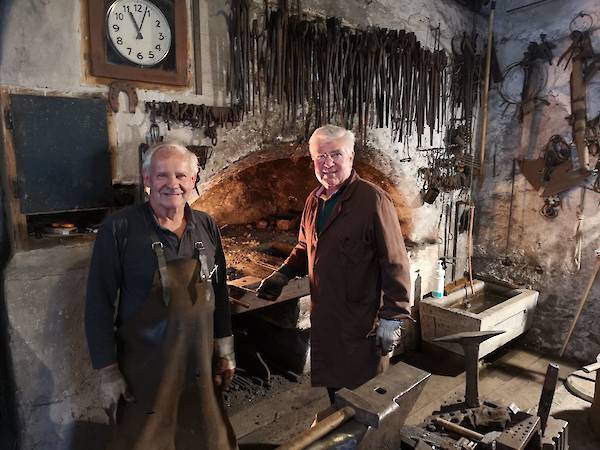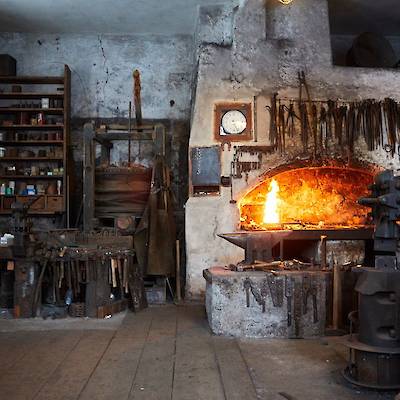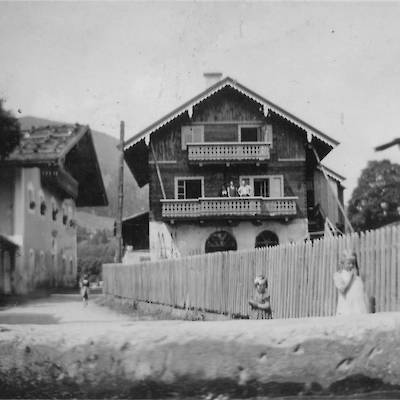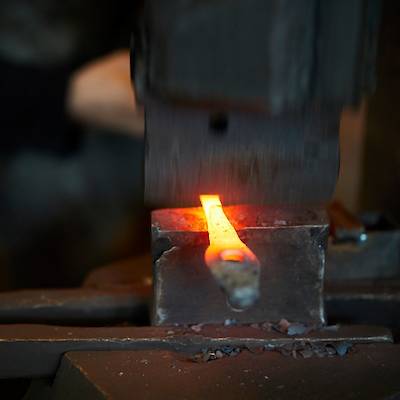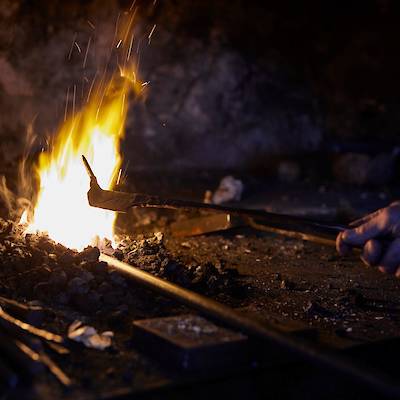The two passionate smiths Reinhard Riedlsperger and Josef Schett have been part of a group of six blacksmiths, who have put a late medieval forge back into operation. Since then, the blacksmiths take turns weekly to revive this almost forgotten craftsmanship. The Gothic period was the heyday of the blacksmith’s trade and is shown in a special exhibition in the Thurnhaus. The two gentlemen have agreed to talk to us and tell us about the old times, the reactivation of the blacksmith, and the future of this rare craft.
Museum: Reinhard, tell us briefly how you came to the craft of forging.
Reinhard Riedlsperger: I started with a locksmith’s apprenticeship at Obernosterer in Zell am See. This apprenticeship included not only the training of locksmiths, but also the work in the forge. I continued working there for several years and learned both the craft of forging and the locksmith’s craft.
Museum: When did you start working at the smithy in Hütten?
Reinhard Riedlsperger: That was ten years ago. We are six blacksmiths and always take turns – each week, one of us works there.
Museum: How did it come about that you were able to reactivate this old smithy in Hütten?
Reinhard Riedlsperger: The idea actually came from the museum, together with Sig Riedlsperger – he wanted to reactivate this and continue the tradition.
Museum: How did you experience the history of the museum? You’ve both been there from the beginning.
Josef Schett: We mostly come to Leogang Museum through various events, weddings, guest-honoring ceremonies, and so on. People have always been very touched by this. Such a wedding, like my son’s one year ago, is something special in these surroundings.
Museum: Were you able to learn something about medieval blacksmithing or eve imitate it?
Josef Schett: You often try to imitate it, but this is something where you reach your limits. The Middle Age was the heyday of blacksmithing and there are so many subtleties you would have to deal with. Today, people don’t take the time to do that either. When I look at such a lock with this intricate mechanism and these many different elements, I get dizzy because I know how much time and effort this means. In the past, time did not play that big of a role, but today, the situation is very different. Today, everything should be fast and cheap.
Museum: What was different about this craft in the past?
Josef Schett: Blacksmithing was a respected craft at the time, because so much was still being done. There were of course a lot of specialists at work, which are hardly to be found today.
Museum: Do you have an explanation for this decrease?
Josef Schett: It was a constant up and down! We learned together; we were in the same company; he was in the middle of his apprenticeship when I started. There were a lot of blacksmiths back then.
Reinhard Riedlsperger: That was the golden age. The number of railings and grates we made – the forge was in operation practically uninterruptedly. There were always between three to four people at work and the fire almost always burned.
Josef Schett: And then it went downhill, work got less. More and more was done by machines.
Reinhard Riedlsperger: Industry had basically taken over the craft.
Josef Schett: What is more, the pieces were expensive at the time, but then a different style took over and everything became more straightforward. We used to love doing those flourishes.
Reinhard Riedlsperger: You have to imagine: every blacksmith has his own individual style; every blacksmith gives his pieces its own note. When I look at a blacksmith’s work in the Pinzgau region today, I know exactly by whom I was done.
Museum: Are there still many people in the Pinzgau region who are still doing this?
Josef Schett: There are still a few, but it has become a lot less overall. The Thorerschmied smith in Saalfelden had beautiful pieces back then. In Bramberg, there is also still a blacksmith and in Stuhlfelden, a young blacksmith is starting a business. He was with us the other day and wants to pursue this old craft.
Museum: What is so special about this craft?
Reinhard Riedlsperger: Blacksmithing is a purely manual work, we do hardly any work using machines. The machines actually only help the blacksmith with his manual work. Every blow to our iron influences it – you can see every move.
